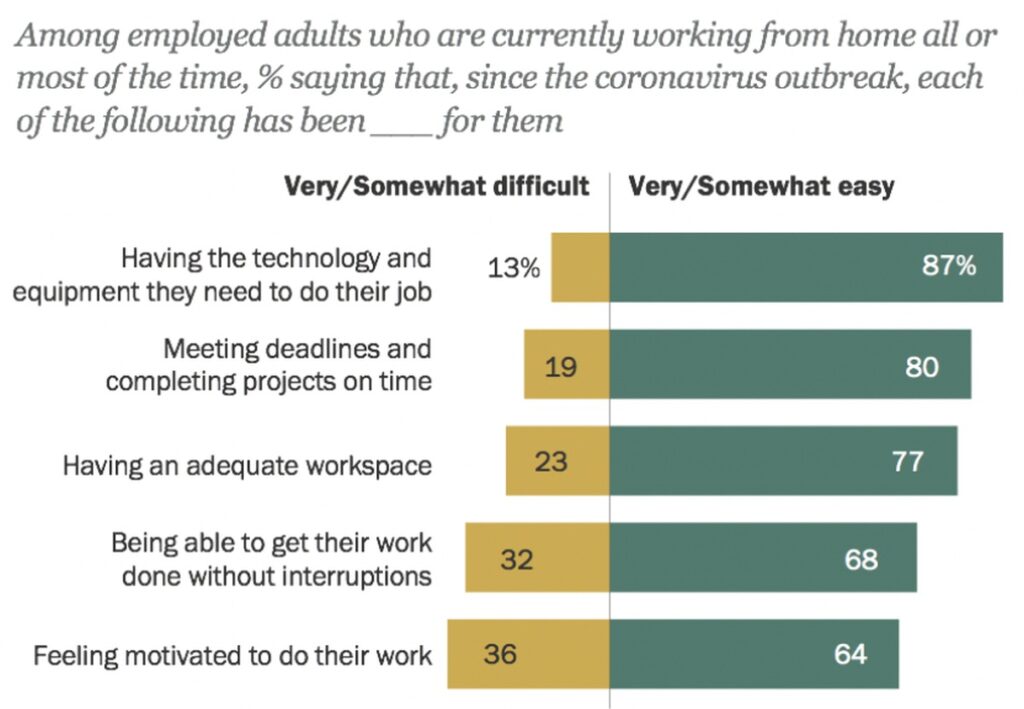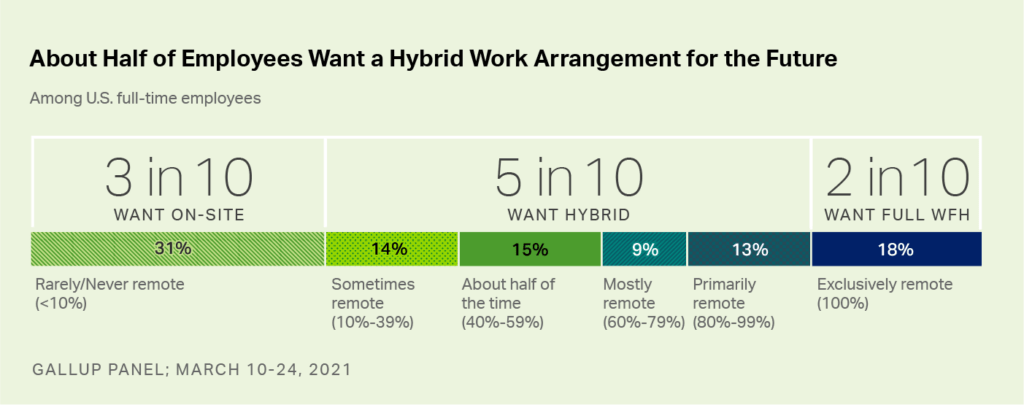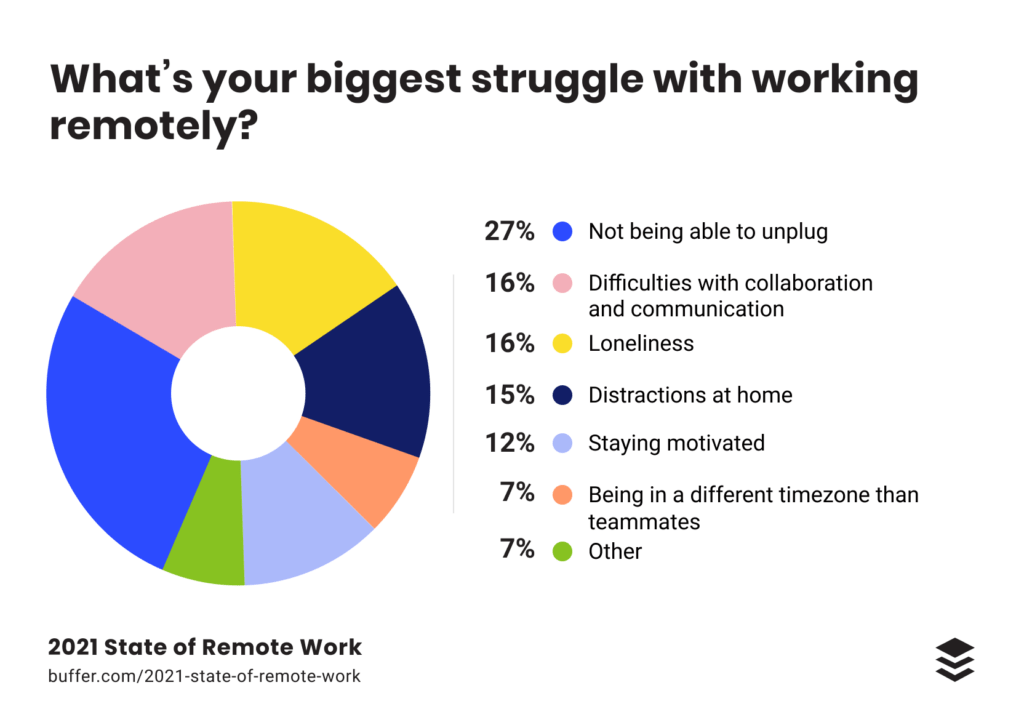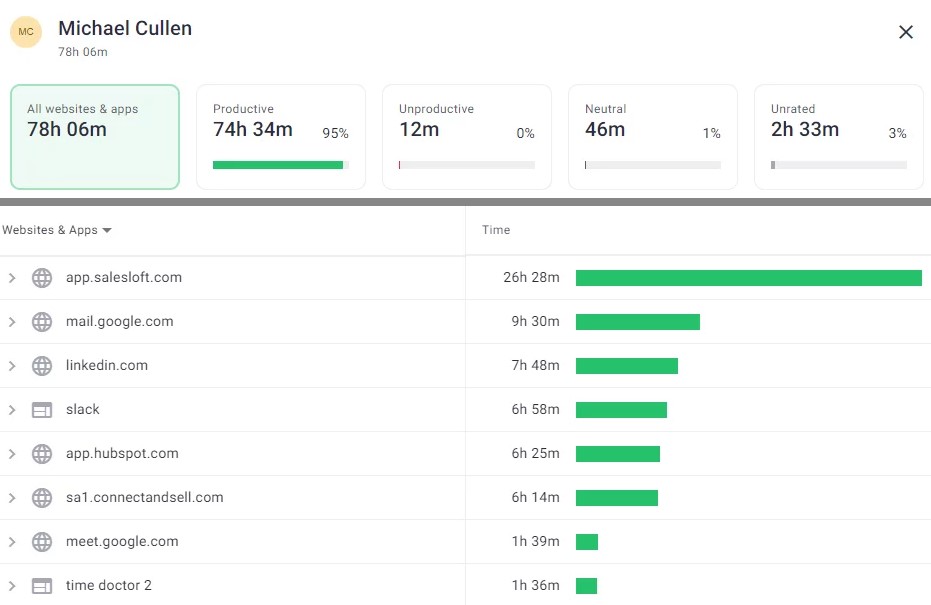When COVID-19 hit in 2020, many businesses were forced to change the way they worked overnight. For some industries, this meant adopting remote work measures that had almost everybody do their usual jobs from home.
For others, this meant slowing down their in-person operations, like manufacturing or logistics, to avoid the spread of the virus.
The effect this had on employee productivity ranged from barely any difference to increased productivity. Some employees, who worked from home said they had more flexibility and were more motivated to do their jobs.

(Source)
In fact, many employees even admitted to working longer hours. They were able to focus on their work because they didn’t have to worry about their commute or long meetings.
But now we’re seeing the effects of mass vaccinations and a slow return to the old way of doing things. In response, most companies are questioning themselves: “Do we go back to normal in-office work, or do we keep the remote working arrangements?”.”
For companies on the fence about going fully remote or adopting a hybrid workplace, the pros and cons are clear.
On the one hand, hybrid teams mean lower overhead costs on office expenses, access to top talent, and happy employees. Around half of employees report that they want to work remotely at least once a week permanently.

(Source)
You might have reservations about ensuring the quality of your employees’ work even if your company is transitioning to a hybrid or remote work environment.
In this blog post, we want to help you with that concern. Keep reading to see 10 actionable ways to improve work performance in the new normal.
How to improve work performance in the new normal
If you’re worried about work performance in the new normal, follow these steps to ensure employee productivity stays up.
1. Clearly define expectations
As with any change, it’s crucial that all employees understand what’s expected of them. Are you adopting a hybrid workplace? Do you expect that employees report to the office a few times a week for meetings and other in-person events? Make that expectation clear.
If you’re going mostly remote, what should employees know about any changes in work policy? Should they be online at specific hours? Or are they free to create their schedule according to how they see fit? How should they handle asking for days off or working around personal errands?
Note if you’ll have changes in the way you measure employees’ work performance. As we move beyond “body in seat productivity,” so too should our standards for our employees’ productivity be as well.
It is easier to keep things on track if everyone is on the same page.
When in doubt, document these new policies and expectations. Keep them somewhere all employees are able to access so that they can refer to them anytime. These changes should also always be communicated in meetings so everyone is aware of these new developments and expectations.
2. Establish the right culture
Your company culture is strong if it survives even when employees do not meet every day in the office.
To make sure productivity doesn’t suffer, it’s important to build a strong remote-friendly culture right from the get-go.
After all, many employees reported that some of their biggest struggles when working from home during the pandemic included not being able to unplug from work, and feeling lonely or isolated from their peers.

(Source)
A company with a strong remote-first culture would have ways to mitigate these employee struggles.
For instance, a strong remote-friendly culture would have safeguards to ensure that employees weren’t overworking by staying on at work too often. They might put up policies about responding to emails or expectations about responses and calling colleagues.
These companies also have ways to ensure remote employees are treated equally as in-office employees, making sure no one feels left out. They have regular video calls with their teams, or virtual activities or chat channels in which anyone can take part.
3. Gamify work milestones
The strategy of gamification has been effective for personal habit change. Hence, we’re not surprised that it can work to improve work performance too. Gamifying work experience means thinking outside the box to make work more engaging and challenging for employees, and in turn, boost morale.
To use this strategy in your own workplace, consider adding game elements into work milestones. These can be completing onboarding or training documents, or finishing a set number of tasks per week.
You can include team managers to help make extremely personalized gamification mechanics for specific teams.
Think outside the box and see how you might turn a regular work week into something that all employees will find a healthy challenge.
4. Embrace the hybrid workplace model
We’ve mentioned the hybrid workplace a few times in this article. But, in this section, we’ll tell you exactly what it might look like and how to adopt it.
Instead of going fully remote or going back to the office, many companies are opting to meet in the middle. The hybrid workplace model includes both in-office and remote setups. It can bring together all the strengths of both while avoiding the weaknesses each might present.
This may be the best workplace model to adopt in the new normal as it brings about benefits like being able to save on expenses.
For instance, companies may give up costly office leases and instead invest in a coworking space. Here the cost is cheaper per employee since many amenities, like printing equipment or conference rooms, are shared.
Yet another benefit is that it still allows the most flexibility for all employees. A few days a week, they’re able to save time, money, and energy from their commutes, and this can help sustain motivation at work.
To find the best hybrid work model for your business, consider how many times a week you may need employees to come to work. You might set this up so that specific teams meet from time to time while others work from home. You can then rotate this setup so everyone gets a chance to meet in person and work from anywhere.
5. Provide your employees the right tools
When businesses had to let their employees work from home because of health and safety concerns, most had to start investing in remote working tools like Zoom.
As you change the way you work to something more flexible, you might find your needs also change.
At this point, to improve work performance, you’ll want to make sure you equip your employees with the best tools to help them get their jobs done well.
Open the floor to team leaders or everyone to name what they believe are some significant pain points or areas of friction. Oftentimes, all they need to lessen this friction is to have the right collaboration tools that support their work better.
Here’s a list of some types of tools we recommend to make for a highly efficient team:
- Remote employee tracking software: Apps like Time Doctor, help employees track their personal productivity and performance at work no matter where they are. Over time, both your employees and your team can notice trends in performance and productivity. This can help everyone learn to optimize their work hours better.

- Video conferencing software: Tools like Zoom or Google Meet facilitate easier virtual meetings, complete with screen-sharing, hand-raising, and Q&A features when needed.
- Cloud office applications: Apps including Google Docs, Google Sheets, and Google Slides make creating, editing, commenting, and collaborating on documents seamlessly.
- Communication tools: Tools like Facebook Workplace, Slack or Discord allow for chatting and messaging when virtual meetings aren’t required. These can help facilitate communication between everyone in your team while keeping different topics and discussions neatly organized and separate.
- Department specific tools: Tools such as cloud accounting software for accounting teams do bookkeeping; backlinking analytics software help marketing teams check competitors’ backlinks or team-friendly graphic design tools allow graphic designers to create and collaborate on marketing collateral.
6. Offer opportunities for growth
Employees need to feel like they’re growing in their jobs if they’re going to stay engaged and productive at work. Because of this, it’s crucial to let your people know where they can be headed if they stay on board and do their jobs well.
Doing this takes some effort. You may need to meet with employees one on one in order to assess their career goals. During these interviews, you can ask employees what they want to achieve in their own lives. This can enable you to see how their job at your business can help contribute to that.
Bear these things in mind whenever you embark on new projects. Some employees might be great candidates to lead new endeavors in line with their goals. Make it clear to everyone that you’re helping them achieve their career goals. Also, make it a point to onboard new hires who know what their potential career paths might look like if they decide to stay onboard the company for the long haul.
7. Respect boundaries
Over the years, we’ve seen how trust has played a vital role in improving work performance. When employees feel trusted and accountable to themselves and their work, they’re more likely to perform better at work and put their best foot forward.
Part of honoring that trust is respecting each person’s boundaries. Boundaries can be anything from their work hours, rest days, communication style and preferences, and more.
As more and more toxic workplace issues are being exposed, we’re seeing that many of these are easily avoidable if all persons in the business took time to lay down their individual boundaries — and have the company support these boundaries themselves.
Here’s an example. For employees to feel like they can truly unplug and take days off, even if they’re not going on vacation, you can encourage them to update their statuses or vacation responders. Ask them to specify who might handle their concerns while they’re away.
Most importantly, respect these boundaries by honoring them. If an employee is truly unable to answer the phone or respond to messages, then insisting on calling or messaging won’t make them feel like their boundaries are being respected.
8. Give importance to your employees’ wellbeing
Burnout becomes a real risk in the modern workplace, as it gets harder for employees to truly unplug from work. Because we’re all equipped with smart technology, the internet, and communication tools that often get abused, it’s no wonder more people are suffering from burnout.
Stay ahead of this danger by putting your employees’ well-being first. Don’t wait for burnout to strike before you create safeguards and policies to ensure your people are being taken care of.
Examples of actionable ways to do this include giving mental health benefits like free therapy sessions, or subsidizing wellness perks, or having a dedicated fund for wellness activities for everyone to enjoy.
Remember that your employees will be the biggest investment in your business. If you take care of them, they take care of your company.
9. Regularly communicate with your employees
Isolation was a big problem during COVID-19. And it will remain a struggle for many employees who will work remotely, even from time to time. Working from home, alone, doesn’t have to be lonely for them.
Make it a point to keep in touch with employees whenever possible. These meetings don’t have to be too often; they can be a few times a quarter and are just a time to touch base and understand how they are.
By doing this, you’re able to help employees know that they’re valued at their job. Listen to them if they have any grievances at work, or if there are milestones or projects they want to pursue.
Even if you aren’t able to meet with everyone individually, you can encourage this open dialogue among teams. Ask managers to be hands on with their employees. Open up Slack or Discord channels for employees to reach higher-ups.
A little goes a long way, and communication is one of the best ways you can ensure work performance is up because of a happy, healthy workforce.
10. Listen to feedback and suggestions
Finally, listen to feedback and suggestions from your team. No one wants to feel like they aren’t being heard or their ideas aren’t being taken seriously.
There is no perfect workplace, but you can always do your best to make sure things stay smooth at your business by listening to employees. When they have suggestions about how to make things better, take these seriously and see how they might be implemented.
If employees see that they are the reason for positive changes in the company, then this might boost employee morale and keep them engaged. They’ll feel like they’re responsible for new improvements, and they may be encouraged to take on even more responsibility and take their work further.
You might need to include some employees in these suggestions or decisions. You can ask them to contribute in helping these ideas or points for improvement a reality. Either way, nobody loses when a company puts aside ego and listens to some of its most important stakeholders.
Conclusion
Improving work performance in the new normal is a valid concern for all companies. After all, as we shift to a new workplace in 2020, so too are we seeing a shift in how we work in the future. But productivity and work performance don’t have to suffer when we make changes in the workplace; in fact, they can improve regardless.
Follow the tips we mention in this blog post to make sure your employees’ productivity stays sharp.
Check out how Time Doctor’s workday insights help you track, measure, and improve employees’ work performance no matter where they are.

Kevin Payne is a content marketing consultant that helps software companies build marketing funnels and implement content marketing campaigns to increase their inbound leads.


